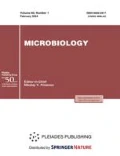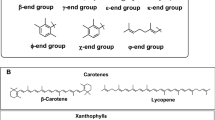Abstract—
The possibility of singlet oxygen generation in five species of photosynthetic bacteria under irradiation with light was studied using the Singlet Oxygen Sensor Green (SOSG) dye that, when singlet oxygen is bound, is transformed into a fluorescent endoperoxide form. Irradiation was carried out using light of different spectral composition: red (absorption of bacteriochlorophyll, BChl) and white (absorption of BChl and carotenoids). No singlet oxygen generation was detected under red light irradiation, which indicated that BChl was not involved in this process. Under white light, as the irradiation time increased, an increase in SOSG fluorescence was recorded in the membranes of four bacterial species: Allochromatium vinosum MSU, Rhodobacter sphaeroides G1C, Rba. blasticus K-1 and Rhodopseudomonas faecalis. In Rba. sphaeroides, no increase in SOSG fluorescence was observed. It is assumed that in the white light this process occurs due to the pigments that absorb in the blue-green region of the spectrum, i.e. carotenoids with 8‒11 conjugated double bonds (neurosporene, spheroidene, lycopene, and rhodopin). Similar to Trolox, SOSG may slow down the bleaching process of BChl850 in the membranes of Alc. vinosum strain MSU and may therefore effectively perform the role of a singlet oxygen trap.








Similar content being viewed by others
REFERENCES
Arellano, J.B., Yousef, Y.A., Melø, T.B., Mahamad, S.B., Cogdell, R.J., and Naqvi K.R., Formation and geminate quenching of singlet oxygen in purple bacterial reaction center, J. Photochem. Photobiol., 2007, vol. 87, pp. 105–112.
Ashikhmin, A.A., Makhneva, Z.K., Bolshakov, M.A., and Moskalenko, A.A., The influence of the number of conjugated double bonds in carotenoid molecules on the energy transfer efficiency to bacteriochlorophyll in light-harvesting complexes LH2 from Allochromatium vinosum strain MSU, Dokl. Biochem. Biophys., 2018, vol. 483, pp. 321–325.
Bancirova, M., Sodium azide as a specific quencher of singlet oxygen during chemiluminescent detection by luminol and Cypridina luciferin analogues, Luminescence. 2011, vol. 26, pp. 685–688.
Berghoff, B.A., Glaeser, J., Nuss, A.M., Zobawa, M., Lottspeich, F., and Klug, G., Anoxygenic photosynthesis and photooxidative stress: a particular challenge for Roseobacter,Environ. Microbiol., 2011, vol. 13, pp. 775–791.
Bol’shakov, M.A., Role of carotenoids in the process of in vivo bacteriochlorophyll photootxidation, Extended Abstract Cand. Sci. (Biol.) Dissertation, Pushchini, 2012.
Bortolus, P. and Monti S., Physical quenching and chemical reaction of singlet molecular oxygen with Azo dyes, J. Organic. Chem., 1989, vol. 54, pp. 534–540.
Chi, S.C., Mothersole, D.J., Dilbeck, P., Niedzwiedzki, D.M., Zhang, H., Qian, P., Vasilev, C., Grayson, K.J., Jakson, P.J., Martin, C.E., Ying, L., and Neil Hunter, C., Assembly of functional photosystem complexes in Rhodobacter sphaeroides incorporating carotenoids from the spirilloxanthin pathway, Biochim. Biophys.Acta–Bioenergetics, 2015, vol. 1847, pp. 189–201.
Cogdell, R.J., Gardiner, A.T., Roszak, A.W., Law, C.J., Southall, J., and Isaacs, N.W., Rings, ellipses and horseshoes: how purple bacteria harvest solar energy, Photosynth. Res., 2004, vol. 81, pp. 207–214.
Cohen-Bazire, G., Sistrom, W.R., and Stanier, R.Y., Kinetic studies of pigment synthesis by non-sulfur purple bacteria, J. Cell. Comp. Physiol., 1957, vol. 49, pp. 25–68.
Cong, H., Niedzwiedzki, D.M., Gibson, G.N., LaFountain, A.M., Kelsh, R.M., Gardiner, A.T., Cogdell, R.J., and Frank, H.A., Ultrafast time resolved carotenoid to-bacteriochlorophyll energy transfer in LH2 complexes from photosynthetic bacteria, J. Phys. Chem. B, 2008, vol. 112, pp. 10689–10703.
Dilbeck, P.L., Tang, Q., Mothersole, D.J., Martin, E.C., Hunter, C.N., Bocian, D.F., Holten, D., and Niedzwiedzki, D.M., Quenching capabilities of long-chain carotenoids in light-harvesting-2 complexes from Rhodobacter sphaeroides with an engineered carotenoid synthesis pathway, J. Phys. Chem. B, 2016, vol. 120, pp. 5429–5443.
Dworkin, M., Endogenous photosensitization in a carotenoidless mutant of Rhodopseudomonas spheroids,J. Gen. Physiol., 1958, vol. 41, pp. 1099–1112.
Fatima, K., Masood, N., and Luqman, S., Quenching of singlet oxygen by natural and synthetic antioxidants and assessment of electronic UV/Visible absorption spectra for alleviating or enhancing the efficacy of photodynamic therapy, Biomed. Res. Ther., 2016, vol. 3, pp. 514–527.
Foote, C.S., Chang, Y.C., and Denny, R.W., Chemistry of singlet oxygen. X. Carotenoid quenching parallels biological protection, J. Amer. Chem. Soc., 1970, vol. 92, pp. 5216–5218.
Fraser, N.J., Hashimoto, H., and Cogdell, R.J., Carotenoids and bacterial photosynthesis: the story so far..., Photosynth. Res., 2001, vol. 70, pp. 249–256.
Gabrielsen, M., Gardiner, A.T., and Cogdell, R.J., Peripheral complexes of purple bacteria, in The Purple Phototrophic Bacteria, Hunter C.N., Daldal F., Thurnauer, M.C., and Beatty, J.T., Eds., 2009, Ch. 8, pp. 135–153.
Glaeser, J. and Klug, G., Photo-oxidative stress in Rhodobacter sphaeroides: protective role of carotenoids and expression of selected genes, Microbiology (SGM), 2005, vol. 151, pp. 1927–1938.
Griffith, M., Sistrom, W.R., Cohen-Bazire, G., and Stanier, R.Y., Functions of carotenoids in photosynthesis, Nature, 1955, vol. 176, pp. 1211–1214.
Gutiérrez, I., Criado, S., Bertolotti, S., Norman, A., and Garcia, N., Dark and photoinduced interactions between trolox, a polar-solvent-soluble model for vitamin E, and riboflavin, J. Photochem. Photobiol., 2001, vol. 62, pp. 133–139.
Hashimoto, H., Uragami, C., Yukihira, N., Gardiner, A.T., and Cogdell, R.J., Understanding/unravelling carotenoid excited singlet states, J. R. Soc. Interface, 2018, vol. 15, article 20180026. https://doi.org/10.1098/rsif.2018.0026
Hoff, A.J. and Deisenhofer, J., Photophysics of photosynthesis. Structure and spectroscopy of reaction centers of purple bacteria, Physics Rep., 1997, vol. 287, pp. l–247.
Kim, S., Fujitsuka, M., and Majima, T., Photochemistry of singlet oxygen sensor green, J. Phys. Chem. B, 2013, vol. 117, pp. 13985–13992.
Kochevar, I.E., Singlet oxygen signaling: from intimate to global, Sci. STKE, 2004, vol. 221. pe7. https://doi.org/10.1126/stke.2212004pe7
Koh, E. and Fluhr, R., Singlet oxygen detection in biological systems: uses and limitations, Plant Signal. Behav., 2016, vol. 11, article e1192742. https://doi.org/10.1080/15592324.2016.1192742
Kondratyeva, Ye.N., Fotosinteziruyushchie bakterii i bakterial’nyi fotosintez (Photosynthetic Bacteria and Bacterial Photosynthesis), Moscow: Mos. Gos. Univ., 1972.
Kraljic, I. and Mohsni, S.El., A new method for the detection of singlet oxygen in aqueous solutions, Photochem. Photobiol., 1978, vol. 28, pp. 577–581.
Krieger-Liszkay, A. and Trebst, A., Tocopherol is the scavenger of singlet oxygen produced by the triplet states of chlorophyll in the PSII reaction centre, J. Exp. Bot., 2006, vol. 57, pp. 1677–1684.
Limantarai, L., Koehler, P., Wilhelm, B., Robert, J., Porra, R.J., and Scheer, H., Photostability of bacteriochlorophyll a and derivatives: potential sensitizers for photodynamic tumor therapy, Photochem. Photobiol., 2006, vol. 82, pp. 770–780.
Makhneva, Z.K., Ashikhmin, A.A., Bolshakov, M.A., and Moskalenko, A.A., 3-Acetyl-chlorophyll formation in light harvesting complexes of purple bacteria by chemical oxidation, Biochemistry (Moscow), 2016, vol. 81, pp. 176–186.
Makhneva, Z.K., Ashikhmin, A.A., Bolshakov, M.A., and Moskalenko, A.A., Protection of BChl850 from action of singlet oxygen in the membranes of sulfur photosynthetic bacterium Allochromatium vinosum strain MSU by quenchers, Microbiology (Moscow), 2019, vol. 88, pp. 79–86.
Makhneva, Z.K., Bolshakov, M.A., Ashikhmin, A.A., Erokhin, Y.E., and Moskalenko, A.A., Influence of blue light on the structure stability of antenna complexes from Allochromatium minutissimum with different content of carotenoids, Biochemistry (Moscow) Supplement. Series A:Membrane and Cell Biology, 2009, vol. 3, pp. 123–127.
Makhneva, Z.K., Erokhin, Yu.E., and Moskalenko, A.A., Carotenoid-photosensitized oxidation of bacteriochlorophyll dimers in light-harvesting complexes B800‒850 in Allochromatium minutissimum cells, Dokl. Biochem. Biophys., 2007, vol. 416, pp. 256–259.
Moskalenko, A.A., Makhneva, Z.K., Fiedor, L., and Scheer, H., Effects of carotenoid inhibition on the photosynthetic RC–LH1 complex in purple sulphur bacterium Thiorhodospira sibirica,Photosynth. Res., 2005, vol. 86, pp. 71–80.
Moskalenko, A.A., Pigment-protein complexes and their interaction in the structures of the bacterial and plant photosynthesis apparatus, Doctoral (Biol.) Dissertation, Pushchino, 1993.
Nuyanzina-Boldareva, E.N., Kalashnikov, A.M., Gaisin, V.A., Sukhacheva, M.V., Kuznetsov, B.B., and Gorlenko, V.M., Characterization of a new strain of a purple nonsulfur bacterium from a thermal spring, Microbiology (Moscow), 2014, vol. 83, pp. 39–46.
Ohara, K., Kikuchi, K., Origuchi, T., and Nagaoka, S., Singlet oxygen quenching by trolox C in aqueous micelle solutions, J. Photochem. Photobiol. B., 2009, vol. 97, pp. 132–137.
Prasad, A., Sedlářová, M., and Pospíšil, P., Singlet oxygen imaging using fluorescent probe Singlet Oxygen Sensor Green in photosynthetic organisms, Sci. Rep., 2018, vol. 8, article 13685. https://doi.org/10.1038/s41598-018-31638-5
Redmond, R.W. and Gamlin, J.N., A compilation of singlet oxygen yields from biologically relevant molecules, Photochem. Photobiol., 1999, vol. 70, pp. 391–475.
Uchoa, A.F., Knox, P.P., Turchielle, R., Seifullina, N.Kh., and Baptista, S.M., Singlet oxygen generation in the reaction centers of Rhodobacter sphaeroides,Eur. Biophys., 2008, vol. 37, pp. 843–850.
ACKNOWLEDGMENTS
The authors are grateful to Professor V.M. Gorlenko (Winogradsky Institute of Microbiology, FRC of Biotechnology, Russian Academy of Sciences, Moscow) for providing Rba. blasticus K-1 and Rps. faecalis cultures; to Professor S. Takaichi (Nippon Medical School, Tokyo, Japan) for providing the Rba.sphaeroides G1C culture, as well as to Z.A. Zhuravleva (IBBP, Russian Academy of Sciences) for assistance in growing bacteria and obtaining membranes.
Funding
This work was supported in part by the Russian Foundation for Basic Research (projects nos. 18-04-00684_a; 18-34-00416_mol_a; 17-04-00929_a). The results presented in Figs. 1–3 were obtained in the framework of the state assignment no. AAAA-A17-117030110140-5.
Author information
Authors and Affiliations
Corresponding author
Ethics declarations
The authors declare that they have no conflict of interest. This article does not contain any studies involving animals or human participants performed by any of the authors.
Additional information
Translated by E. Babchenko
Accepted abbreviations: BChl, bacteriochlorophyll; Crt, carotenoid; LH, light-harvesting; RC, reaction center; Alc.,Allochromatium; Rba.,Rhodobacter; Rps., Rhodopseudomonas;Rsb., Roseobacter; SOSG, Singlet Oxygen Sensor Green.
Rights and permissions
About this article
Cite this article
Makhneva, Z.K., Ashikhmin, A.A., Bolshakov, M.A. et al. Carotenoids are Probably Involved in Singlet Oxygen Generation in the Membranes of Purple Photosynthetic Bacteria under Light Irradiation. Microbiology 89, 164–173 (2020). https://doi.org/10.1134/S0026261720010099
Received:
Revised:
Accepted:
Published:
Issue Date:
DOI: https://doi.org/10.1134/S0026261720010099




